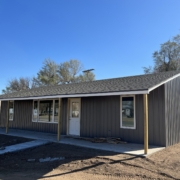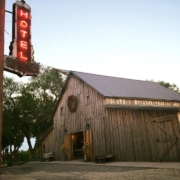By Beccy Tanner
The Stafford County Zoning Commission has unanimously given their approval for a special use permit that help sets the stage for constructing the Port Authority of Stafford County.
Final approval, though, lies in the hands of the Stafford County Commission, which are set to hear the zoning case in October.
The Port Authority of Stafford County will be located near the junction of US-50 and US 281 highways, near a BNSF railroad mainline.
It is a site where hundreds of cars and trucks pass daily.
And while those vehicles will continue to pass daily by the site, there is hope that a 256-acre site will soon be constructed and handle full-size grain trains of more than 100 railcars and semi-trucks that can carry more than just grain but merchandise and consumer goods that may eventually pump as much as $7-to-9 million into the local economy.
The new Port Authority will in fact be a transportation and shipping hub.
Carolyn Dunn, president of the Port Authority and who currently is the Stafford County Economic Development’s Strategic Projects Manager presented the case to the zoning board, Sept. 12.
Dunn is also the county’s former economic development director and has been involved in the county’s development for the past 12 years.
“I was made aware that we were missing some critical business opportunities in the very first few months of economic development being in existence in 2011,” Dunn told the board. “We had a company at the time that was interested in putting a unit car loading facility here and had some purchase options on land but then decided to locate somewhere in Nebraska, instead. We subsequently had two other companies that considered Stafford County closely but invested somewhere else.”
Stafford County, because of its rural population, does not have a large labor force to attract manufacturers. But it does have agricultural products that can bring investment opportunities into the county.
And that is what local business and agriculture leaders are hoping to draw on.
“We are at the crossroads of two U.S. highways that intersect with the mainline railroad,” Dunn said. “It’s not an accident. Some of these companies that were considering Stafford County as a location is because we do have that strategic location when it comes to transportation.”
Additionally, there are few other public points of entry to a major railroad in the western 2/3 of Kansas. Those that do have rail service are owned by private companies, who control who uses the tracks.
“So, that is something we can put out there as an advantage that we could offer for developing,” Dunn said. “Our purpose here is to create more and better-quality jobs that diversify the economy. One of the biggest goals for me is to increase the tax base with the goal of preserving essential services and quality of life.”
Because construction of the Port Authority will be costly, Dunn said, she wanted to do it in such a way that local taxpayers would not have to pay for it.
“We’ve made an application to the Federal Railroad administration … There is no way we would have even had an application worth sending in if we hadn’t already had over $5 million secured and other components already in place. It’s a very long process,” Dunn has said previously. “There have been a lot of different entities along the way that have been willing to be open and helpful to us. I feel we have the kind of support that the FRA looks for from the Kansas Department of Commerce, Department of Agriculture and the Department of Transportation. We have the support of both our U.S. Senators, US Representatives, and State Rep. Brett Fairchild, and local representatives who have endorsed us.”
The $5 million that has already secured for the Port came from a $2.5 million BASE grant through the Kansas Department of Commerce and a $2.5 million appropriation in the Omnibus Appropriations Bill (HB 2510). Another $800,000 was awarded to Stafford County Economic Development to loan to the Port Authority with flexible repayment terms.
Yet, more money is needed – at least another $5 million—which Dunn has applied for and is hopeful the county will receive.
That’s why the special use permit is needed – as part of the process.
“What we have is agriculture and we are missing the opportunities to capture some investment in the benefits that that brings because we maybe didn’t have the right tools to really make it an appealing investment for potential businesses,” Dunn said.










